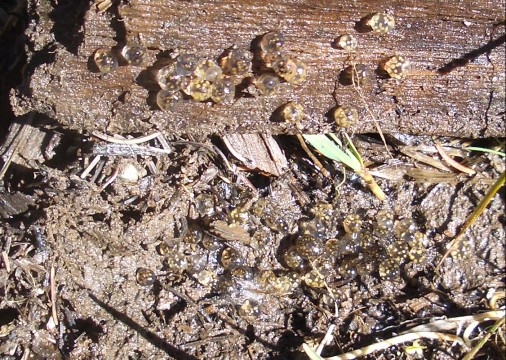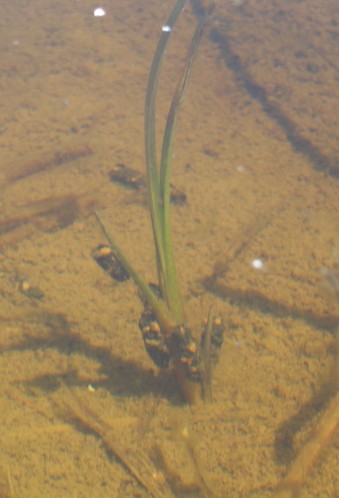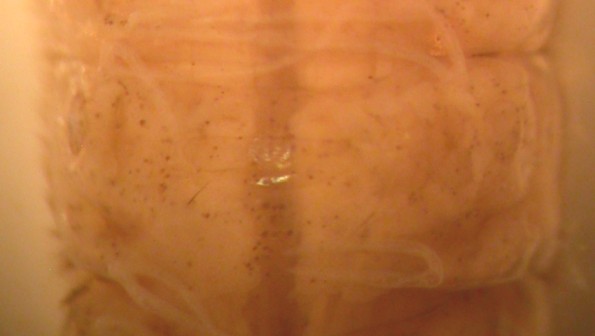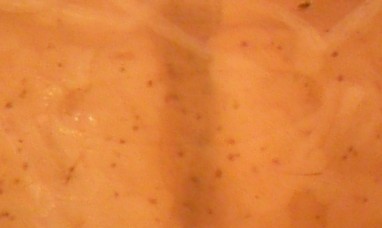Trichoptera: Limnephilidae of Gunnison County, ColoradoAsynarchus nigriculus(Banks) 1908Updated 1 March 2024
TSN 116238  Egg masses in a wet spot under a log at the edge of a pond. This species is sometimes hard to separate from various Limnephilus species found in the same habitat. The defining character is that Asynarchus larvae have dorsal chloride epithelia, while Limnephilus sp. do not. However, immature and poorly preserved animals can be difficult to tell apart. A. nigriculus has been studied extensively at The Rocky Mountain Biological Laboratory by Scott Wissinger and colleagues. Interestingly this species commonly cannibalizes its fellow larvae in the race to emerge from temporary habitats before they dry. Good LinksOn this website:Introduction to the Limnephilidae Other Websites: Photos, Map, Museum specimens, DNA - Barcodinglife.org ReferencesBalik,JA; Leitz,C; Washko,SE; Cleveland,B; Krejsa,DM; Perchik,ME; Stogsdill,A; Vlah,M; Demi,LM; Greig,HS and Shepard,ID 2022 Species-specific traits predict whole-assemblage detritus processing by pond invertebrates. Oecologia, 199(4), pp.951-963.Balik,JA; Taylor,BW; Washko,SE and Wissinger,SA 2018 High interspecific variation in nutrient excretion within a guild of closely related caddisfly species. Ecosphere, 9(5) p.e02205. PDF Banks, N 1908 Neuropteroid insects - notes and descriptions. Transactions of the American Entomological Society 34:255-267. Described as Anabolia nigricula.  
Demi,LM; Hughes,D and Taylor,BW 2022 Characterizing the role of phosphorus availability and periphytic algae in the food choice and performance of detritivorous caddisflies (Trichoptera: Limnephilidae). Freshwater Science, 41(1) 18-32. PDF Abstract: "Organisms that rely on detritus as their primary food source may face particularly strong nutritional constraints on growth and development, given the characteristically poor quality of detrital resources. In freshwater ecosystems, the low content of P in detritus often limits detritivore growth. Additionally, a growing body of evidence suggests the biochemical composition of algae, such as essential fatty acids, can limit aquatic detritivore growth. We investigated feeding preference and growth responses of common aquatic detritivores by performing paired feeding-preference and growth experiments on 4 species of larval caddisflies (Trichoptera) from the family Limnephilidae: Asynarchus nigriculus, Anabolia bimaculata, Limnephilus externus, and Ecclisomyia sp. We manipulated both the P content and epiphytic algal biomass of a common detrital food resource (decomposing sedge [Carex sp.]) by conditioning the detritus under 2 different light (ambient, shaded) and P (ambient [low], +P) regimes. We tested 3 hypotheses that describe feeding preferences and performance under different scenarios of P limitation, algal limitation, and co-limitation by P and algae. We observed evidence of preferential feeding behavior for each of the 4 taxa, with 2 species exhibiting preferences for conditioned detritus with high algal biomass and 2 for detritus from the +P treatments. We observed agreement between feeding preferences and performance (growth, growth efficiency, mortality) for only 2 taxa, with A. nigriculus exhibiting higher growth rates and growth efficiency on their preferred high- P detritus, and L. externus experiencing lower mortality when reared on their preferred high algal biomass detritus. These findings provide an initial step toward characterizing the feeding preferences and performance responses of aquatic detritivores to 2 potentially common nutritional constraints: detrital P and algal supply." Finn,DS and Poff,NL 2008 Emergence and flight activity of alpine stream insects in two years with contrasting winter snowpack. Artic, Antarctic, and Alpine Research 40(4)638-646. PDF Greig,HS and Wissinger,SA 2010 Reinforcing abiotic and biotic time constraints facilitate the broad distribution of a generalist with fixed traits. Ecology, 91(3) 836-846. PDF Herrmann,SJ; Ruiter,DE and Unzicker,JD 1986 Distribution and records of Colorado Trichoptera. Southwestern Naturalist 31(4) 421-457. The authors show this species present in Gunnison County. Lund,JO; Wissinger,SA and Peckarsky,BL 2016 Caddisfly behavioral responses to drying cues in temporary ponds: implications for effects of climate change. Freshwater Science, 35(2), pp.619-630. PDF Abstract: " Aquatic organisms that live at high latitudes and elevations are especially vulnerable to climate-change-induced alterations in snowpack, snowmelt, and evaporation rates, all of which affect basin filling and drying dates. Extraordinarily early drying events in shallow ponds and wetlands at our study sites prompted us to conduct 2 mesocosm experiments to document how proximate cues of drying modify agonistic behaviors among larvae of the caddisfly, Asynarchus nigriculus. Larvae are mainly detritivores but can be extremely aggressive and engage in mob cannibalism, perhaps to obtain a dietary supplement that hastens escape from drying basins. In one experiment, we manipulated caddisfly density to simulate the effects of crowding during pond drying. In a 2nd experiment, we reduced water levels and manipulated a protein supplement that mimics the dietary benefits of cannibalism. We quantified the effects of those manipulations on aggressive behaviors that are precursors to cannibalism and on development time to pupation. Frequency and duration of agonistic encounters increased as a function of larval density and, independent of density, were higher in drying than nondrying treatments, especially in the absence of a protein supplement. Pupation occurred earlier in high- than low-density treatments and earlier with than without a protein supplement. In contrast, the timing of pupation was not accelerated in drying compared with nondrying treatments, which might reflect the extreme diel temperature fluctuations in drying ponds, hence suboptimal growth conditions. Our findings provide evidence that declining water levels and crowding serve as cues that enable caddisflies to adjust behavior and development in the face of habitat drying. Early drying events observed in recent years may exceed the limits of this flexibility and portend the demise of populations in temporary habitats that historically supported this species."  McCullagh,BS; Wissinger,SA and Marcus,JM 2015 Identifying PCR primers to facilitate molecular phylogenetics in Caddisflies (Trichoptera). Zoological Systematics, 40(4) 459 PDF
McCullagh,BS; Wissinger,SA and Marcus,JM 2015 Identifying PCR primers to facilitate molecular phylogenetics in Caddisflies (Trichoptera). Zoological Systematics, 40(4) 459 PDFSchmid,F 1954 Le genre Asynarchus McL. (Trichopt., Limnoph.). Mitteilungen der Schweizerischen Entomologischen Gesellschaft 27:57-96. Reviews the adults of Asynarchus. Tigreros,N and Davidowitz,G 2019 Flight-fecundity tradeoffs in wing-monomorphic insects. Advances in insect physiology, 56, pp.1-41. PDF Wissinger,SA 2004 Population fluctuations in caddisflies inhabiting high-elevation wetlands in central Colorado. Presented at the NABS Annual meeting, Vancouver, British Columbia, in Population Ecology 2 Abstract Wissinger,SA; Brown,WS and Jannot,JE 2003 Caddisfly life histories along permanence gradients in high altitude wetlands in Colorado (U.S.A.). Freshwater Biology 48(2). PDF (427 Kb) Wissinger,SA; Eldermire,C and Whissel,JC 2005 The role of larval cases in reducing aggression and cannibalism among caddisflies in temporary wetlands. Wetlands 24(4) 777-783. PDF Abstract: " Larvae of wetland caddisflies supplement their detrital diets with animal material. In some species this supplement is obtained by preying on other caddisflies. In this study, we conducted a series of laboratory experiments to a) compare intraspecific aggression and the propensity for cannibalism among six caddisfly species that occur along a gradient from vernal to autumnal to permanent high-elevation wetlands, and b) determine the importance of cases in preventing or reducing cannibalism and intraguild predation. We predicted that cannibalism and overall levels of aggression should be highest in species that occur in temporary habitats. We found that all of the species that use temporary habitats (Asynarchus nigriculus ,Hesperophylax occidentalis, Limnephilus externus, Limnephilus picturatus, Limnephilus secludens) were extremely aggressive towards and cannibalized conspecifics without cases. Species that typically occur in short-duration temporary wetlands were more aggressive than those in long-duration temporary wetlands. Cases prevented cannibalism in four of these temporary-habitat species, and reduced cannibalism among Asynarchus larvae. The latter species occurs in extremely ephemeral habitats where cannibalism provides a dietary supplement that probably facilitates emergence before drying. Asynarchus also preys on Limnephilus spp., and we found that cases dramatically reduced vulnerability to intraguild predation. Larvae of Agrypnia deflata, a species that occurs only in permanent wetlands, were least aggressive and rarely cannibalized conspecifics. Our results are consistent with the hypothesis that intraspecific aggression and the potential for cannibalism are highest in species that live in habitats with developmental time constraints. Many wetland invertebrates face developmental time constraints and selection for aggression in temporary habitats should be especially strong for taxa that rely on animal material to supplement a mainly detrital diet." Wissinger,SA; Sparks,GB; Rouse,GL; Brown,WS and Steltzer,HM 1996 Intraguild predation and cannibalism among larvae of detritivorus caddisflies in subalpine wetlands. Ecology 77 (8) 2421-2430. Read online Abstract: " Comparative data from subalpine wetlands in Colorado indicate that larvae of the limnephilid caddisflies, Asynarchus nigriculus and Limnephilus externus, are reciprocally abundant among habitats-Limnephilus larvae dominate in permanent waters, whereas Asynarchus larvae dominate in temporary basins. The purpose of this paper is to report on field and laboratory experiments that link this pattern of abundance to biotic interactions among larvae. In the first field experiment, growth and survival were compared in single and mixed species treatments in littoral enclosures. Larvae, which eat mainly vascular plant detritus, grew at similar rates among treatments in both temporary and permanent habitats suggesting that exploitative competition is not important under natural food levels and caddisfly densities. However, the survival of Limnephilus larvae was reduced in the presence of Asynarchus larvae. Subsequent behavioral studies in laboratory arenas revealed that Asynarchus larvae are extremely aggressive predators on Limnephilus larvae. In a second field experiment we manipulated the relative sizes of larvae and found that Limnephilus larvae were preyed on only when Asynarchus larvae had the same size advantage observed in natural populations. Our data suggest that the dominance of Asynarchus larvae in temporary habitats is due to asymmetric intraguild predation (IGP) facilitated by a phenological head start in development. These data do not explain the dominance of Limnephilus larvae in permanent basins, which we show elsewhere to be an indirect effect of salamander predation. Behavioral observations also revealed that Asynarchus larvae are cannibalistic. In contrast to the IGP on Limnephilus larvae, Asynarchus cannibalism occurs among same-sized larvae and often involves the mobbing of one victim by several conspecifics. In a third field experiment, we found that Asynarchus cannibalism was not density-dependent and occurred even at low larval densities. We hypothesize that Asynarchus IGP and cannibalism provide a dietary supplement to detritus that may be necessary for the timely completion of development in these nutrient-poor, high-elevation wetlands." Wissinger,SA; Whiteman,HH; Sparks,GB; Rouse,GL and Brown,WS 1999 Foraging trade-offs along a predator-permanence gradient in subalpine wetlands. Ecology 80, 2102-2116. PDF Abstract: " We conducted a series of field and laboratory experiments to determine the direct and indirect effects of a top predator, the tiger salamander (Ambystoma tigrinum nebulosum), on larvae of two species of limnephilid caddisflies (Limnephilus externus and Asynarchus nigriculus) in subalpine wetlands in central Colorado. Asynarchus larvae predominate in temporary wetlands and are aggressive intraguild predators on Limnephilus larvae, which only predominate in permanent basins with salamanders. We first conducted a field experiment in mesocosms (cattle tanks) to quantify the predatory effects of different life stages of salamanders on the two caddisfly species. Two life stages of the salamanders (larvae and paedomorphs) preferentially preyed on Asynarchus relative to Limnephilus. Subsequent laboratory experiments revealed that high Asynarchus activity rates and relatively ineffective antipredatory behaviors led to higher salamander detection and attack rates compared to Limnephilus. In a second field experiment (full factorial for presence and absence of each of the three species), we found that salamander predation on Asynarchus had an indirect positive effect on Limnephilus: survival was higher in the presence of salamanders + Asynarchus than with just Asynarchus. In the laboratory we compared the predatory effects of salamanders with and without their mouths sewn shut and found the observed indirect positive effect on Limnephilus survival to be mainly the result of reduced numbers of Asynarchus rather than salamander-induced changes in Asynarchus behavior. We argue that indirect effects of predator-predator interactions on shared prey will be mainly density-mediated and not trait-mediated when one of the predators (in this case, Asynarchus) is under strong selection for rapid growth and therefore does not modify foraging behaviors in response to the other predator. The reciprocal dominance of Limnephilus and Asynarchus in habitats with and without salamanders probably reflects a trade-off between competitive superiority and vulnerability to predation. The high activity levels and aggressiveness that enable Asynarchus to complete development in temporary habitats result in strong asymmetric competition (via intraguild predation) with Limnephilus. In permanent habitats these same behaviors increase Asynarchus vulnerability to salamander predation, which indirectly benefits Limnephilus. This and previous work implicate salamanders as keystone predators that exert a major influence on the composition of benthic and planktonic assemblages in subalpine wetlands." Wissinger,SA; Steinmetz,J; Alexander,JS and Brown,WS 2004 Larval cannibalism, time constraints, and adult fitness in caddisflies that inhabit temporary wetlands. Oecologia 138, 39-47. PDF Abstract: " The fitness of non-feeding adult insects depends on energy accumulated during the larval stage. Larvae of the caddisfly Asynarchus nigriculus primarily feed on plant detritus, but supplement their diet with animal material obtained through cannibalism. Habitat drying constrains development in many populations of this species, and we hypothesized that cannibalism should accelerate development to facilitate timely metamorphosis. We manipulated larval diets in a field experiment by supplementing detritus with animal material, and in a laboratory experiment by varying animal material and detritus quality (conditioned vs unconditioned). We measured the effects of dietary manipulation on larval and pupal growth and development, the timing of metamorphosis, and adult fitness correlates. The results of the laboratory experiment suggest that this species can metamorphose with a detritus-only diet, but development is extremely protracted. In the field experiment, individuals with animal material in their diet had higher larval survival, shorter larval and pupal development times, and earlier emergence dates (7-10 days), than those without a supplement. This delay in emergence should have important effects on survival in natural populations where the difference between desiccation and successful emergence can be only a few days. Dietary supplementation also affected adult body mass (30-40% increase), female fecundity (30% more eggs), and proportional allocation to different adult body parts. Our results are consistent with recent growth-development models that predict coupled (earlier emergence and larger adults) rather than tradeoff responses (earlier emergence and smaller adults) to pre-threshold manipulation of larval diets. Many detritivorous aquatic insects supplement their diets with animal material, and our data provide evidence that this supplementation can have strong effects on fitness. This type of dietary supplementation should be especially important for taxa that do not feed as adults, and in temporary habitats that impose time constraints on larval development." Wissinger,SA; Whissel,J; Eldermire,C and Brown,W 2006 Predator defense along a permanence gradient: roles of case structure, behavior, and developmental phenology in caddisflies, Oecologia:1-12. PDF (311 KB) Abstract: "Species replacements along freshwater permanence gradients are well documented, but underlying mechanisms are poorly understood for most taxa. In subalpine wetlands in Colorado, the relative abundance of caddisfly larvae shifts from temporary to permanent basins. Predators on caddisflies also shift along this gradient; salamanders (Ambystoma tigrinum nebulosum) in permanent ponds are replaced by predaceous diving beetles (Dytiscus dauricus) in temporary habitats. We conducted laboratory and field experiments to determine the effectiveness of caddisfly cases in reducing vulnerability to these predators. We found that larvae of a temporary-habitat caddisfly (Asynarchus nigriculus) were the most vulnerable to salamanders. Two relatively invulnerable species (Limnephilus externus, L. picturatus) exhibited behaviors that reduced the likelihood of detection and attack, whereas the least vulnerable species (Agrypnia deflata) was frequently detected and attacked, but rarely captured because cases provided an effective refuge. Vulnerability to beetle predation was also affected by cases. The stout cases of L. externus larvae frequently deterred beetle larvae, whereas the tubular cases of the other species were relatively ineffective. Two of these vulnerable species (A. nigriculus and L. picturatus) often co-occur with beetles; thus, case construction alone is insufficient to explain patterns of caddisfly coexistence along the permanence gradient. One explanation for the coexistence of these two species with beetles is that they develop rapidly during early summer and pupate before beetle larvae become abundant. One species (L. picturatus) pupates by burying into soft substrates that serve as a refuge. The other (A. nigriculus) builds stone pupal cases, which in field experiments, more than doubles survival compared to organic pupal cases. The combined results of these experiments suggest that caddisfly distributions along permanence gradients depend on a suite of primary and secondary predator defenses that include larval and pupal case structure, predator-specific escape behaviors, and the phenology of larval development." Photos of chloride epitheliaFinding the elusive chloride epethilia on a Limnephilid caddisfly can be a triumphant moment at the microscope. I hope these photos help people know what to look for. Look for the shiny horizontal oval in about the center of the photo. Notice the faint dark edge or border. While this photo is not the best, it is fairly similar to what you see under an average microscope.  Closeup of a different chloride epethilia on the same animal. |